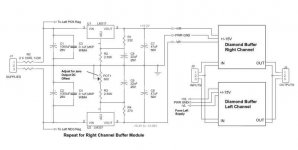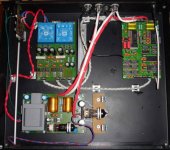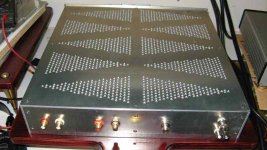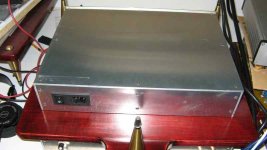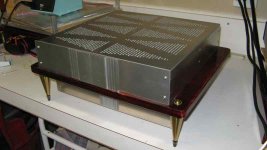Algar_emi said:Here the schematic of the carrier PCB
Hi
Scary to see the output offset can be adjusted by means of the supply voltage....
best
Algar_emi said:I know, but since the buffer module are made by surface mount and very difficult to modify, it seems like the easiest thing to do. Anyway, it was impossible to get the exact matched pair transistors for both half of the circuit, so...
Hi Algar,
I understand. The reason I mention it is that the circuit must have low power supply rejection so requires a good power supply....
best
Hi,
I also started this Tube DAC. I started in 2001 and I finished on november 2005. Yes, I know it's a long time.
But it is well worth it !! And I don't sell it too.....
Also thanks of my friend ( Peter Beyer ) who helped me with it.
Tubes are the Sovtek 6N1P-EV and the Brimar 6x4 smoke glass.
I can also changed the Sovtek for a SQ Philips E88CC. When I do this then I have to put 2 resitors ( 150R) out of the little PCB in front of the tube. The 6N1P-EV got a higher heater current.
I also started this Tube DAC. I started in 2001 and I finished on november 2005. Yes, I know it's a long time.
But it is well worth it !! And I don't sell it too.....
Also thanks of my friend ( Peter Beyer ) who helped me with it.
Tubes are the Sovtek 6N1P-EV and the Brimar 6x4 smoke glass.
I can also changed the Sovtek for a SQ Philips E88CC. When I do this then I have to put 2 resitors ( 150R) out of the little PCB in front of the tube. The 6N1P-EV got a higher heater current.
Attachments
I just received my new Mark levinson ML37 Reference CD transport.
I used it right away with my two best DAC, the Super Tube DAC and the Assemblage 2.6 DAC.
Comments:
-It is true that a good transport can show of what an external is capable of (or not for that matter). The ML37 makes both DAC sounds at their best. The Assemblage DAC is much better with the ML37 than with a good CD player, my Copland CDA277.
-The Tube DAC can show any weak link. The best equipments can show that this DAC is a top, reference grade performer.
-With the best Tube DAC and D-60 Cable, the sound is liquid, not digital sound at all. Hights are clear, pristine. Sax for example sounds woody like they should. Music has life. It is not flat like all digital music usually is.
-The better digital cable, the better. I use the Kimber D-60 Illumination and it is a worthy upgrade.
-The bad news is that it sounds so good with good transport and digital cable that you will have the upgrade bug...
I compared between these digital cables:
-Kimber Illuminations D-60, lenght 1 m, dual RCA connectors, with RCA to BNC adapters
-DIY Cable: Belden T9116, Duobond Braid Shield, Low Loss, RG-6 75 ohms coaxial (2 cables), Amphenol 31-70000, True 75 ohms BNC connector. lenght 24"
-Normal 50 ohms BNC cable, RG-58, commercial grade.
-Digital cables type makes a real difference when you have equipment with enough resolution to show it.
-The worst cable is the plain RG-8 (50 ohms) BNC cable. Not that bad but we hear a digital glear and flatter sound, as expected...
-The biggest difference is heard with the Assemblage DAC that doesn't have a low jitter clock and PLL to reduce jitter.
The D-60 Illuminati makes a hugue difference in sound compare to the real 75 ohms, low loss, Belden RG-6 in this case. The difference is so big that it seems like the volume is higher, not a little change at all...
-With the Super Tube DAC with low jitter and PLL, the difference is less, but the Illumination is still better. We can hear with better precision little details. But the Belden RG-6 is maybe 85% of the D-60. It is interesting to hear that a jitter reduction circuit can reduce and almost eliminate digital cable sound difference. So jitter on the SPDIF is a major contribution to the DAC-Transport sound. A confirmation again of a well known fact I guess...
-Interesting to see that we can make ourself a very good digital cable using known industrial grade components as the Belden low loss RG-6 and true 75 ohms Amphenol BNC connectors. However if the DAC is of lower quality, the better the cable, the better the result...
-Naturally I compare the sounds of the BNC and RCA SPDIF on the ML37 and the BNC is a real winner.
-The better Kimber D-60 is still a worthy upgrade if you have a very good transport...
Equipments:
ML37 Reference CD Transport
DIY Tube DAC (Guido Tent design) and Assemblage 2,6 DAC
SDS Headphone Amplifier
Grado SR125 Headphones
I used it right away with my two best DAC, the Super Tube DAC and the Assemblage 2.6 DAC.
Comments:
-It is true that a good transport can show of what an external is capable of (or not for that matter). The ML37 makes both DAC sounds at their best. The Assemblage DAC is much better with the ML37 than with a good CD player, my Copland CDA277.
-The Tube DAC can show any weak link. The best equipments can show that this DAC is a top, reference grade performer.
-With the best Tube DAC and D-60 Cable, the sound is liquid, not digital sound at all. Hights are clear, pristine. Sax for example sounds woody like they should. Music has life. It is not flat like all digital music usually is.
-The better digital cable, the better. I use the Kimber D-60 Illumination and it is a worthy upgrade.
-The bad news is that it sounds so good with good transport and digital cable that you will have the upgrade bug...
I compared between these digital cables:
-Kimber Illuminations D-60, lenght 1 m, dual RCA connectors, with RCA to BNC adapters
-DIY Cable: Belden T9116, Duobond Braid Shield, Low Loss, RG-6 75 ohms coaxial (2 cables), Amphenol 31-70000, True 75 ohms BNC connector. lenght 24"
-Normal 50 ohms BNC cable, RG-58, commercial grade.
-Digital cables type makes a real difference when you have equipment with enough resolution to show it.
-The worst cable is the plain RG-8 (50 ohms) BNC cable. Not that bad but we hear a digital glear and flatter sound, as expected...
-The biggest difference is heard with the Assemblage DAC that doesn't have a low jitter clock and PLL to reduce jitter.
The D-60 Illuminati makes a hugue difference in sound compare to the real 75 ohms, low loss, Belden RG-6 in this case. The difference is so big that it seems like the volume is higher, not a little change at all...
-With the Super Tube DAC with low jitter and PLL, the difference is less, but the Illumination is still better. We can hear with better precision little details. But the Belden RG-6 is maybe 85% of the D-60. It is interesting to hear that a jitter reduction circuit can reduce and almost eliminate digital cable sound difference. So jitter on the SPDIF is a major contribution to the DAC-Transport sound. A confirmation again of a well known fact I guess...
-Interesting to see that we can make ourself a very good digital cable using known industrial grade components as the Belden low loss RG-6 and true 75 ohms Amphenol BNC connectors. However if the DAC is of lower quality, the better the cable, the better the result...
-Naturally I compare the sounds of the BNC and RCA SPDIF on the ML37 and the BNC is a real winner.
-The better Kimber D-60 is still a worthy upgrade if you have a very good transport...
Equipments:
ML37 Reference CD Transport
DIY Tube DAC (Guido Tent design) and Assemblage 2,6 DAC
SDS Headphone Amplifier
Grado SR125 Headphones
okay, why not make this thread longer?? I used to work for a company manufacturing 2.5GHz SERDES (Serializer/Deserializer) for SONET applications. "The sound of Digital cables" bugs me. There is either high BER (Bit Error Rate), or not. If the data is strobed correctly, the data will remain valid. The signal can be jittered quite a bit (no pun intended) before you actually get bit errors. If the bits are received well through the performance of the receiver, they are clocked out with crystal accuracy. I see that the worst "sounding"cable is RG-58. A properly designed S/PDIF Tx source impedance is 75 ohms. The worst "sounding" cable likely had high bit-error-rate due to the transmission line mis-match. If you match impedances through the source, connector, cable and terminate properly, the bit-error rate is kept low, therefore the data remains valid, yielding low error data transmission. Once the the data arrives at the receiver, it can be screwed up however you want it to be. Crimp on 75 ohm connectors to keep the impedance discontinuities low through the connector (Canare) and Belden 1505, or whatever decent 75 ohm wire you want to use and you'll be fine. I'd be happy to participate in an A-B-X listening test, but I got to tell you, I'm not likely to hear a difference between data cables with low BER
I agree that the difference in sound is caused by impedance mis-match in the case of the RG-58 (50 ohms) and the other two 75 ohms cable used, as you said it correctly again, with the 75 ohms SPDIF. This was the most basic check to do when comparing digital cables. I just stated this example for maybe some new member that is not aware of the importance of using the correct impedance cable in case of digital transmission. I'm pretty sure that some guys are still using any kind of cable on their DAC 
I used to measure this stuff almost every day for 7 years, working in a RF calibration lab and I think I know the basics
I can still hear a difference between the D-60 and the Belden, even small. Who knows what is happening to the bits mixed around in real time. Maybe the Kimber D-60 used more perfect connectors or better coax. I don't know. I just enjoy the music more with the D-60.
I don't try to argue here, just to express my own personnal finding. Not everybody need to agree.
Any other small contribution to the never ending subject of cable sounds
I used to measure this stuff almost every day for 7 years, working in a RF calibration lab and I think I know the basics
I can still hear a difference between the D-60 and the Belden, even small. Who knows what is happening to the bits mixed around in real time. Maybe the Kimber D-60 used more perfect connectors or better coax. I don't know. I just enjoy the music more with the D-60.
I don't try to argue here, just to express my own personnal finding. Not everybody need to agree.

Any other small contribution to the never ending subject of cable sounds
I'm sorry, I didn't mean to come off like a jerk. We used to use BERt's and measure error rate. Some error rates were so low, that we had to use regression techniques to predict errors over years. A TDR or network analysis measurement should provide a great way to optimise an interface. If the eye pattern can be made to look pristine on the interface, it would be up to the source Tx and Rx receiver quality to insure low error rates. This should be able to be done with an array of qulity components. I still see Monster cable selling hand soldered cables for 75 ohm applications. Sure they work, but with what margin or error rate? Understood about putting the wrong impedance interface to make a point. I currently work for a well known audio company and I get frustrated with the level of misunderstanding regarding digital interfaces within the company. I think it's a good topic
mrshow4u,
Accordingly with Algar_emi, also I don't try to argue here. Because, before arguing , I think you should LEARN here, a lot.
SPDIF is not about BER. SPDIF is about embedded clock to be recovered by a pll from the manchester encoded transmission channel,
and by the smallest jitter possible. In this sentence, where have You seen data clocked out by crystal accuracy?
I would suggest this, as a start, with exceptional emphasis on the last article listed, the Hawksford one.
http://www.diyhifi.org/forums/viewtopic.php?p=7857#7857
and some other threads, clearing up a lot of basics and finesse:
http://www.diyhifi.org/forums/viewtopic.php?p=5609#5609
http://www.diyhifi.org/forums/viewtopic.php?p=9572#9572
http://www.diyhifi.org/forums/viewtopic.php?p=5900#5900
Accordingly with Algar_emi, also I don't try to argue here. Because, before arguing , I think you should LEARN here, a lot.
SPDIF is not about BER. SPDIF is about embedded clock to be recovered by a pll from the manchester encoded transmission channel,
and by the smallest jitter possible. In this sentence, where have You seen data clocked out by crystal accuracy?
I would suggest this, as a start, with exceptional emphasis on the last article listed, the Hawksford one.
http://www.diyhifi.org/forums/viewtopic.php?p=7857#7857
and some other threads, clearing up a lot of basics and finesse:
http://www.diyhifi.org/forums/viewtopic.php?p=5609#5609
http://www.diyhifi.org/forums/viewtopic.php?p=9572#9572
http://www.diyhifi.org/forums/viewtopic.php?p=5900#5900
mrshow4u,
Visibly You know your material. We are talking about a non -standard
situation here, maybe Pedja's words are clearing it up better [from those threads].
Visibly You know your material. We are talking about a non -standard
situation here, maybe Pedja's words are clearing it up better [from those threads].
Signal period or more commonly a "unit interval" (UI) are the measures usually discussed in the data transitions. Jitter here matters only if it comes that high to introduce bit errors.
However, as I've said above, the problem with the jitter in audio is that influences conversion, bringing certain artifacts that are considered to be critical for the ear. You have more on these mechanisms in Dunn's articles.
Pedja
mrshow4u no offense 
Thanks Joseph. Very informative articles. A good start is also the full articles discussion of Guido Tent design choices that produce his Tube Dac. These justification for the design choices were the main reasons why I choose to build this DAC, see: http://members.chello.nl/~m.heijligers/DAChtml/tech.htm
and in particular:
http://members.chello.nl/~m.heijligers/DAChtml/PLL/PLL1.htm
SPDIF is not a great digital interface to start with. Any help here with the signal transmission and its best recovery using a PLL and a good low jitter clock (supplied with a low noise supply) is well welcome to get the best sound
So I guest that a good digital cable can save the day...

Thanks Joseph. Very informative articles. A good start is also the full articles discussion of Guido Tent design choices that produce his Tube Dac. These justification for the design choices were the main reasons why I choose to build this DAC, see: http://members.chello.nl/~m.heijligers/DAChtml/tech.htm
and in particular:
http://members.chello.nl/~m.heijligers/DAChtml/PLL/PLL1.htm
SPDIF is not a great digital interface to start with. Any help here with the signal transmission and its best recovery using a PLL and a good low jitter clock (supplied with a low noise supply) is well welcome to get the best sound
So I guest that a good digital cable can save the day...
Algar,
I can only confirm your finds: it's my long time experience that this DAC
[which was a team's work, let's don't leave out people like Marc Heijligers] is still "reactive" or "responsive" to the SPDIF input quality,
reclocking notwithstanding. And it rewards the efforts with a beautiful sound..
We have listened to a Northstar 192 dac quite extensively. That dac is less responsive to the SPDIF input, with it's on-board ASRC and local crystal oscillator. But still there are clear differences..
It's nice to see that You still like the sound of it. How about Peter's Dac in comparison?
Ciao, George
Ps.: As it might be seen in those threads, I've seen some problems with the digital input's behaviour.. though that can be only my realization, I'm rather afraid that it's more due to the transformer chosen.. Guido in fact uses an another type these days.
New test are due..
I can only confirm your finds: it's my long time experience that this DAC
[which was a team's work, let's don't leave out people like Marc Heijligers] is still "reactive" or "responsive" to the SPDIF input quality,
reclocking notwithstanding. And it rewards the efforts with a beautiful sound..
We have listened to a Northstar 192 dac quite extensively. That dac is less responsive to the SPDIF input, with it's on-board ASRC and local crystal oscillator. But still there are clear differences..
It's nice to see that You still like the sound of it. How about Peter's Dac in comparison?
Ciao, George
Ps.: As it might be seen in those threads, I've seen some problems with the digital input's behaviour.. though that can be only my realization, I'm rather afraid that it's more due to the transformer chosen.. Guido in fact uses an another type these days.
New test are due..
You're right it was a team effort, sorry I didn't mean to offense the other team members. It is right also that the transfo choice is of the most importance being the first to receive the signal and match the impedance.
I still didn't listen to my version of PD DAC with this setup. Don't forget that this is my own version of it, not really Peter final design. I know that he tried a few different PCB layout before choosing the right one. I did just one...
Peter is using an active digital receiver, no transformer. The DAC is also quite different and has no PLL or low jitter clock. It may be more sensitive do the digital cable and transport choice.
Next in my list of listening tests.
I still didn't listen to my version of PD DAC with this setup. Don't forget that this is my own version of it, not really Peter final design. I know that he tried a few different PCB layout before choosing the right one. I did just one...
Peter is using an active digital receiver, no transformer. The DAC is also quite different and has no PLL or low jitter clock. It may be more sensitive do the digital cable and transport choice.
Next in my list of listening tests.
- Status
- This old topic is closed. If you want to reopen this topic, contact a moderator using the "Report Post" button.
- Home
- Source & Line
- Digital Source
- I started my new Tube DAC
